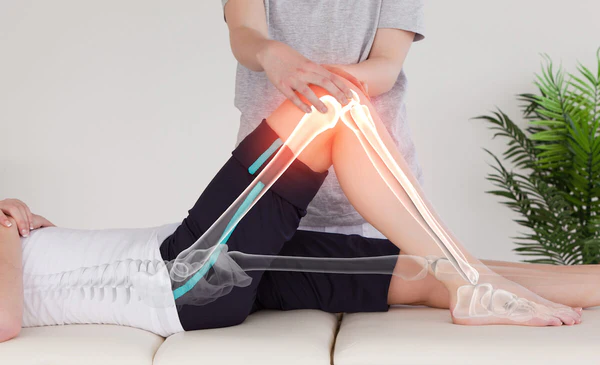Plantar fasciitis is a common condition that affects the heel and bottom of the foot, causing pain and stiffness. However, many people may not realize that plantar fasciitis can also contribute to pain in other parts of the body, including the knees.
If left untreated, the condition can lead to imbalances that place extra stress on the knee joints, potentially resulting in discomfort or even long-term damage.In this article, we will explore the relationship between plantar fasciitis and knee pain, the causes, symptoms, and effective treatment options.
What is Plantar Fasciitis?

If you’ve ever woken up with sharp pain in your heel when taking your first steps, you might be dealing with plantar fasciitis. This condition happens when the plantar fascia, a thick band of tissue that runs from the heel to the toes, becomes inflamed. This tissue plays an important role in supporting the arch of your foot and absorbing shock when you walk or run.
But when it’s overstressed—whether from too much standing, running, or even wearing unsupportive shoes—it can develop tiny tears. Over time, these small injuries lead to stiffness, discomfort, and even long-term foot problems if left untreated.
Common Causes of Plantar Fasciitis:
Several factors can contribute to the development of plantar fasciitis:
- Overuse Injury – Running, jumping, or prolonged standing can strain the plantar fascia.
- Obesity – Extra weight increases pressure on the feet.
- Foot Structure Issues – Flat feet or high arches can affect foot mechanics.
- Tight Calf Muscles – Limited flexibility in the lower leg can increase stress on the foot.
- Improper Footwear – Worn-out or unsupportive shoes can contribute to inflammation.
Symptoms of Plantar Fasciitis:
Individuals with plantar fasciitis may experience:
- Sharp heel pain, especially in the morning or after inactivity.
- Stiffness and swelling in the heel or foot arch.
- Increased pain after long periods of standing or walking.
If left untreated, plantar fasciitis can lead to complications, including knee pain and mobility issues.
Can plantar fasciitis cause knee pain even if I don’t have foot pain?
Yes, plantar fasciitis can alter your walking pattern, leading to knee strain even if foot pain is mild or absent. When your foot doesn’t move properly, your body naturally adjusts to reduce discomfort. Over time, this can put extra stress on your knees, causing pain and stiffness. In some cases, the strain may also affect your hips and lower back.
If you notice knee discomfort without an obvious injury, it’s worth checking if your foot alignment is the issue. Wearing supportive shoes and doing stretching exercises can help prevent further pain.
The Connection Between Plantar Fasciitis and Knee Pain:
Plantar fasciitis primarily affects the foot, but its impact can extend up the leg to the knee joint. This occurs due to changes in gait, posture, and biomechanics.
How Plantar Fasciitis Leads to Knee Pain?
- Altered Walking Patterns – When foot pain prevents normal walking, individuals may unconsciously adjust their gait, placing extra pressure on the knees.
- Increased Joint Stress – A misaligned walking posture can strain the knee joint, leading to inflammation and pain.
- Weakening of Supporting Muscles – The muscles and tendons in the lower body work together. When the foot is in pain, the muscles in the knees and legs may compensate, leading to discomfort.
Other Areas Affected by Plantar Fasciitis:
In addition to knee pain, plantar fasciitis can contribute to:
- Ankle pain due to changes in movement.
- Hip discomfort caused by improper weight distribution.
- Lower back pain as the body compensates for foot misalignment.
If you are experiencing knee pain alongside plantar fasciitis, addressing both issues is essential for a full recovery.
How long does it take to recover from plantar fasciitis and knee pain?
Recovery time for plantar fasciitis and knee pain varies, but most people start feeling better within 6–12 months with proper treatment. However, healing depends on several factors, such as the severity of your condition, your daily activities, and how well you follow your treatment plan.
If you rest, stretch regularly, and wear supportive footwear, you may recover faster. On the other hand, ignoring the pain or continuing activities that strain your feet and knees can slow down recovery. For stubborn cases, physical therapy or advanced treatments may be needed to speed up healing.
Also Read: Can Sciatica Cause Knee Pain – Understanding the Connection!
Best Treatment Options for Plantar Fasciitis and Knee Pain:
Physical Therapy:
Physical therapy is one of the most effective treatments for both plantar fasciitis and knee pain. It helps improve flexibility, strength, and gait to support proper movement and reduce strain.
How Physical Therapy Helps:
- Stretching Exercises – Helps loosen tight calf muscles and the plantar fascia.
- Strength Training – Builds muscles in the knees, ankles, and feet for better stability.
- Gait Training – Corrects walking posture to prevent excessive strain on the joints.
Orthotic Support:
Using custom orthotic inserts or supportive footwear can redistribute weight more evenly, reducing stress on the plantar fascia and knee joint.
Types of Orthotic Support:
- Custom Insoles – Provide tailored support based on foot shape.
- Arch Support Shoes – Help maintain proper foot alignment.
- Heel Cups & Pads – Reduce impact on the heel and knees.
Stretching and Flexibility Exercises:
Regular stretching helps improve mobility, reduce tightness, and prevent further strain on the plantar fascia and knee joint.
Key Exercises for Pain Relief:
- Calf Stretch – Loosens tight lower leg muscles.
- Toe Stretch – Targets the plantar fascia directly.
- Knee Extension Exercises – Strengthens knee joints and improves support.
Anti-Inflammatory Treatments:
Reducing inflammation can help ease pain and promote faster healing. There are several methods to achieve this.
Common Anti-Inflammatory Treatments:
- Ice Therapy – Applying ice packs to reduce swelling and pain.
- NSAIDs (Non-Steroidal Anti-Inflammatory Drugs) – Medications like ibuprofen can help manage inflammation.
- Corticosteroid Injections – For severe pain, doctors may recommend steroid injections to relieve swelling.
Proper Footwear:
Wearing supportive shoes can prevent excessive strain on the feet and knees.
Features of the Right Footwear:
- Cushioned Soles – Absorbs impact when walking.
- Arch Support – Helps align the feet properly.
- Shock Absorption – Reduces stress on the knees and plantar fascia.
Lifestyle Modifications:
Making small lifestyle changes can significantly reduce pain and discomfort.
Effective Lifestyle Adjustments:
- Weight Management – Losing excess weight can ease pressure on the feet and knees.
- Activity Modifications – Avoid standing for long hours or engaging in high-impact activities.
- Rest & Recovery – Allow time for proper healing.
Surgical Options (For Severe Cases):
Surgery is only considered when conservative treatments fail.
Common Surgical Procedures:
- Plantar Fascia Release – A procedure to relieve tension in the plantar fascia.
- Endoscopic Surgery – Minimally invasive surgery to repair damaged tissue.
Making the right treatment choice can help relieve pain and improve mobility, ensuring a faster recovery.
FAQ’s
1. What are the first signs of plantar fasciitis-related knee pain?
The first signs include mild knee discomfort, stiffness, or pain when walking or standing for long periods. Over time, the pain may worsen due to changes in your walking pattern, causing extra strain on the knee joint.
2. Can losing weight help with plantar fasciitis and knee pain?
Yes, maintaining a healthy weight reduces pressure on the feet and knees, helping to relieve pain. Even a small amount of weight loss can make a big difference in reducing strain and improving mobility.
3. Is walking good or bad for plantar fasciitis and knee pain?
Walking in supportive shoes and on soft surfaces can help, but excessive walking on hard surfaces may worsen symptoms. It’s best to balance activity with rest and use proper footwear to prevent further strain.
4. Can plantar fasciitis lead to other joint problems?
Yes, if left untreated, plantar fasciitis can cause misalignment in the legs, leading to issues in the ankles, hips, and even the lower back. Proper treatment can help prevent long-term complications.
5. Should I see a doctor if my knee pain from plantar fasciitis doesn’t improve?
Yes, if your knee pain persists despite home treatments, consult a doctor or physical therapist. They can evaluate your condition, suggest customized treatment options, and rule out other possible causes of knee pain.
Conclusion:
Plantar fasciitis can do more than just cause foot pain—it can affect your knees, hips, and even your lower back if left untreated. The way you walk changes when your feet hurt, putting extra stress on your joints. Fortunately, with proper treatment, including stretching, supportive footwear, and lifestyle adjustments, you can relieve pain and prevent further complications. If your symptoms persist, seeking medical advice can help ensure a full recovery and long-term joint health.






